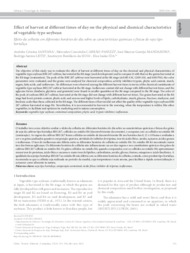Effect of harvest at different times of day on the physical and chemical characteristics of vegetable-type soybean.
Effect of harvest at different times of day on the physical and chemical characteristics of vegetable-type soybean.
Autoria: SANTANA, A. C.; CARRÃO-PANIZZI, M. C.; MANDARINO, J. M. G.; LEITE, R. S.; SILVA, J. B. da; IDA, E. I.
Resumo: ABSTRACT: The objective of this study was to evaluate the effect of harvest at different times of day on the chemical and physical characteristics of vegetable-type soybean BRS 267 cultivar, harvested at the R6 stage (seed development) and to compare it with that on the grains harvested at the R8 stage (maturation). The pods of the BRS 267 cultivar were harvested at the R6 stage (at 8:00 AM, 12:00 AM, and 6:00 PM), the color parameters were evaluated, and the grains were analyzed for chemical composition, activity inhibitor trypsin, phytic acid content, starch, sugars, fatty acids, and isoflavones. No differences were observed among the different harvest times in terms of the chemical constituents of vegetable-type soybean BRS 267 cultivar harvested at the R6 stage. Isoflavones content did not change with different harvest times, and the aglycone forms (daidzein, glycitein, and genistein) were found in smaller quantities at the R6 stage compared to the R8 stage. The color of the pods of soybean BRS 267 cultivar, harvested at the R6 stage did not change with different harvest times. The grains harvested at the R6 stage had lower protein content, phytic acid, and sucrose and higher levels of lipids, carbohydrates, starch, glucose, fructose, stachyose, and linolenic acids than those collected at the R8 stage. The different times of harvest did not affect the quality of the vegetable-type soybean BRS 267 cultivar harvested at stage R6. Nevertheless, it is recommended to harvest in the morning, when the temperature is milder, like other vegetables, to facilitate and optimize its marketing and in natura consumption. RESUMO: Efeito da colheita em diferentes horários do dia sobre as características químicas e físicas de soja tipo hortaliça. O trabalho teve como objetivo avaliar o efeito da colheita em diferentes horários do dia sobre as características químicas e físicas dos grãos de soja da cultivar tipo hortaliça BRS 267, colhidos no estádio R6 (desenvolvimento da semente), e comparar com os colhidos no estádio R8 (maturação). As vagens da cultivar BRS 267 foram colhidas no estádio de desenvolvimento R6 nos horários das 8, 12 e 18 horas e avaliadas a cor e os grãos analisados quanto à composição química, atividade do inibidor de tripsina, teor do ácido fítico, amido, açúcares, ácidos graxos e isoflavonas. O teor de isoflavonas não diferiu entre os diferentes horários de colheita no estádio R6. No estádio R8 foi encontrado maior teor das formas agliconas. Os diferentes horários de colheita não influenciaram na cor das vagens e nos constituintes químicos dos grãos da cultivar BRS 267 colhida no estádio R6. Os grãos colhidos no estádio R6, quando comparados com os colhidos no estádio R8, apresentaram menor teor de proteínas, ácido fítico e sacarose e maior teor de lipídios, carboidratos, amido, glicose, frutose, estaquiose e ácido linolênico. A qualidade da soja tipo hortaliça BRS 267 no estádio R6 não diferiu com os diferentes horários de colheita, contudo, como produto tipo hortaliça, recomenda-se que a colheita seja realizada no período da manhã, cuja temperatura é mais amena, para facilitar a rápida comercialização e consumo como alimento in natura.
Ano de publicação: 2012
Tipo de publicação: Artigo de periódico
Unidade: Embrapa Trigo
Observações
1 - Por padrão são exibidas publicações dos últimos 20 anos. Para encontrar publicações mais antigas, configure o filtro ano de publicação, colocando o ano a partir do qual você deseja encontrar publicações. O filtro está na coluna da esquerda na busca acima.
2 - Para ler algumas publicações da Embrapa (apenas as que estão em formato ePub), é necessário ter, no celular ou computador, um desses softwares gratuitos. Sistemas Android: Google Play Livros; IOS: iBooks; Windows e Linux: software Calibre.
Acesse outras publicações
Acesse a Base de Dados da Pesquisa Agropecuária (BDPA) para consultar o acervo completo das bibliotecas da Embrapa.

